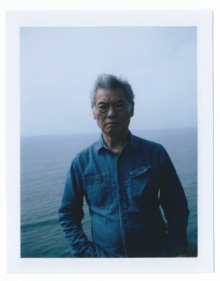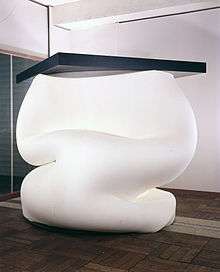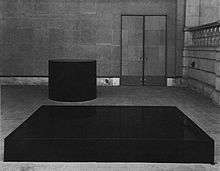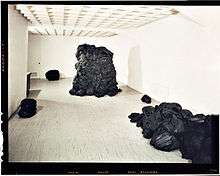Nobuo Sekine
Nobuo Sekine (関根 伸夫, Sekine Nobuo, September 19, 1942 – May 13, 2019) was a Japanese sculptor who resided in both Tokyo, Japan, and Los Angeles, California.
Nobuo Sekine | |
|---|---|
 Artist Nobuo Sekine facing away from the Pacific Ocean, ca. 2014, Palos Verdes Peninsula, CA. Photo: Gaea Woods | |
| Born | September 19, 1942 Saitama, Japan |
| Died | May 13, 2019 (aged 76) Los Angeles, California, United States |
| Nationality | Japanese |
| Education | Tama Art University |
| Known for | Contemporary Art |
Notable work | Phase-Mother Earth |
| Movement | Mono-ha |
| Website | http://www.nobuosekine.com |
He was one of the key members of Mono-ha, a group of artists who became prominent in the late 1960s and 1970s. The Mono-ha artists explored the encounter between natural and industrial materials, such as stone, steel plates, glass, light bulbs, cotton, sponge, paper, wood, wire, rope, leather, oil, and water, arranging them in mostly unaltered, ephemeral states. Works which come under the Mono-ha umbrella focus as much on the interdependency of the aforementioned elements and the surrounding space as on the materials themselves.
Early career
Nobuo Sekine was born in 1942 in Shiki City, Saitama Prefecture, Japan. From 1962 to 1968, he was a student in the painting department at Tama Art University in Tokyo, where he studied under influential artist-teachers Yoshishige Saito and Jiro Takamatsu. Takamatsu’s illusionistic paintings and sculpture were central to the development of the Tokyo art scene at that time.
Sekine’s early work reflected this approach. He was included in the seminal Tricks and Vision: Stolen Eyes group exhibition held at Tokyo Gallery and Muramatsu Gallery in 1968. There, he exhibited Phase No.4 (1968) (位相 No.4), a wall-mounted sculpture. Depending on the angle from which one viewed this work, its cylindrical shape appeared whole or fragmented. Sekine held his first solo exhibition at Tokyo Gallery the following year.
Phase—Mother Earth
| Phase-Mother Earth | |
|---|---|
 "Phase—Mother Earth", 1968 Earth, cement Cylinder: 220 x 270 (diameter) cm, hole: 220 x 270 (diameter) cm Installation view at 1st Kobe Suma Rikyū Park Contemporary Sculpture Exhibition Courtesy of the artist Photo by Osamu Murai | |
| Artist | Nobuo Sekine |
| Year | 1968, 2008 and 2012 |
| Type | earth art |
| Dimensions | 2.7 m × 2.2 m (110 in × 87 in); 2.2 m diameter (87 in) |
The major turning point in Sekine’s career came in October 1968, when he created the work Phase: Mother Earth in Kobe’s Suma Rikyu Park for the First Open Air Contemporary Sculpture Exhibition (第一回野外彫刻展). Made with the assistance of Susumu Koshimizu and Katsuro Yoshida, the work consisted of a hole dug into the ground, 2.7 meters deep and 2.2 meters in diameter, with the excavated earth compacted into a cylinder of exactly the same dimensions.
He conceived the work as a “thought experiment” that would deal with the laws of awareness of phases of space—a form of “reasoned thought that deduces whether or not one’s hypotheses are true, and in some cases, can ignore the physical phenomena of reality.” He further elaborated.... "If you dig a hole in the earth and keep digging forever, eventually the earth will be like an eggshell, and if you go on to pull out all the earth, it will be reversed into a negative version of itself. "[1]
Phase—Mother Earth was an early manifestation of Sekine’s engagement with the concept of “phase” (位相) in topology (位相幾何学), a branch of mathematics concerned with abstract space and connectedness—specifically the properties that are preserved under continuous deformations. Through this discipline, Sekine perceived form, matter, and space as infinitely malleable.
Phase-Mother Earth is considered to be the initial work of the Mono-ha movement.[2] The work was re-created in 2008 [3] and again in 2012.
Other Important Works
Phase—Sponge (1968) (位相:スポンジ) was a white cylinder of sponge, distorted under the weight of a black sheet of iron laid on top of it. One can understand from this work that structure remains the same even if there are changes in form, and that what is deformed can be restored to its original shape.Writing about this work, Lee Ufan suggested that “perhaps all primitive people had to do was to stack up rocks like dolmens. However, in today’s industrial society, an iron plate on a sponge cylinder more naturally elicits a response”[4]

Steel plate, sponge
130 x 120 x 120 cm
Installation view at 5th Nagaoka Contemporary Art Museum Prize (first prize), Seibu Department Store, Tokyo, November 16–27, 1968.
Courtesy of the artist
Photo by Eizaburō Hara
At Sekine’s first solo exhibition at Tokyo Gallery in 1969, he exhibited Phase of Nothingness—Oil Clay (1969) (空相—油土), which consisted of a huge mass of oil clay exhibited in its natural state. Viewers were allowed to touch this work and reshape it, implying that sculpted or not, and in contrast to its dominant physical presence, this “sculpture” was transient. Of this piece, curator Simon Groom wrote:[5]
Simply presented in its natural state, the huge mass of clay seems to exist in a constant state of tension between our awareness of its overwhelmingly physical presence and our conscious desire to form it, whether mentally through the profusion of possible forms it may suggest, or physically, drawn as we are to the tactile nature of the material in its infinite malleability.
— Simon Groom, “Encountering Mono-ha”, Mono-ha: School of Things, Kettle’s Yard, p.8, 2001
Phase of Nothingness—Water (1969) (空相:水) consisted of two containers of water, one a 110 cm high cylinder and the other a 30 cm high rectangular box. The containers were painted black so that the water would appear invisible, but as viewers were allowed to touch the work, once they did so, ripples made the presence of the water known.

Steel, lacquer, water
30 x 220 x 160 cm, 120 x 120 x 120 cm
Installation view at the 9th Contemporary Art Exhibition of Japan, Tokyo Metropolitan Art Museum, May 10–30, 1969.
Courtesy of the artist
Phase Of Nothingness / Venice Biennale
In July 1970, along with Shusaku Arakawa, Sekine was chosen to exhibit at the Japan Pavilion at the Venice Biennale. He contributed Phase of Nothingness (空相), which consisted of a large stone placed on top of a tall square column of mirrored stainless steel. The column reflects the surrounding scenery and almost disappears from view, while the stone appears to float in the air.
His success at the Venice Biennale led to him being offered a number of solo shows in Europe, including a traveling exhibition featuring a major body of sculptural work, Phase of Nothingness—Black (1978–79)(空相—黒) .
Phase Of Nothingness—Black
Phase of Nothingness—Black (1978–79) (空相—黒) is a lesser-known but equally important series, consisting of black FRP sculptures that contrast the natural and the manmade. The approximately 50 sculptures range from rough, clod-like forms that lie low on the floor to highly polished, geometric shapes that stand tall like totems. These works marked a crucial shift in Sekine’s practice—away from a focus on raw materials and malleability and toward the surface qualities of solidified forms. Sekine deliberately made it difficult to identify the material used to create these works—at first glance it is not evident whether they are made of stone, glass, metal, or plastic. When Sekine installed these works, he considered their placement to be a “topological scene” governed by aesthetic principles similar to those found in Zen rock gardens—namely, asymmetric arrangements of disparate elements that combine to represent a broader landscape of seas, islands, and mountains.

Dimensions variable
Installation view at Tokyo Gallery, April 18 - May 2, 1969.
Courtesy of the artist
Photo by Nobuo Sekine
Intellectual Exchange With Lee Ufan
In November 1968, Sekine met the Korean-born artist Lee Ufan, who was soon to be of central importance to Mono-ha and the articulation of its ideas. Lee had studied a variety of philosophies, including the writings of Lao Tzu and Chuang Tzu (which also came to influence Sekine’s work), and after moving to Japan in 1956, had studied modern Western philosophy at Nihon University. Lee recognized the progressiveness of Sekine’s ideas and admired his work, while Sekine found in Lee a theoretician to support his artistic practice and views of art.[6]
In a series of commentaries that appeared in various art magazines from 1969 to 1970, Lee claimed to have identified the emergence of “a new structure” revealing “the world as it is.” Lee’s theory privileged “things or substances” arranged in a “site” which together produce an “encounter with being,” vividly real and free of subject/object bifurcation. “Sekine’s act, then, does not mean to turn the world into an object of cognition as with the case of objet,” Lee wrote, “but to liberate it amidst non-objective phenomena, into the realm of perception; that is, to let the world be in its own being.”[7]
Exhibitions
Sekine’s first solo exhibition was at Tokyo Gallery in 1969. Since then, he has had numerous solo shows in Japan, including at the Venice Biennale in 1970. Solo exhibitions of his work have been held in Copenhagen, [La Bertesca Gallery] Genova, [La Bertesca Gallery] Milan, Tokyo, and Nagoya.
From 1978 to 1979, “Phase of Nothingness—Black” was the subject of a solo exhibition which toured from the Künsthalle Düsseldorf, Germany, to the Louisiana Museum of Modern Art, Humlebæk, Denmark; the Kröller-Müller Museum, Otterlo, Netherlands; and the Henie-Onstad Art Centre, Høvikodden, Norway.
Sekine has also been included in landmark surveys, such as Reconsidering Mono-ha, National Museum of Art, Osaka, 2005; Japanese Art after 1945: Scream Against the Sky, held at Yokohama Museum of Art, Guggenheim Museum SoHo, New York, and San Francisco Museum of Modern Art, 1994; and Japon des Avant Gardes 1910–1970, Centre Georges Pompidou, Paris, 1986.
Sekine’s work has received renewed attention in the United States following his inclusion in Requiem for the Sun: The Art of Mono-ha, at Blum & Poe, Los Angeles, in February 2012. This exhibition was the first survey of Mono-ha in the United States. Sekine’s work was also featured in Tokyo 1955–1970: A New Avant Garde at the Museum of Modern Art, New York, in 2012. Also, his first solo show in the United States was held at Blum & Poe in January 2014.
Sekine was represented by the galleries Blum & Poe (Los Angeles, New York, Tokyo) and Tokyo Gallery + BTAP (Tokyo, Beijing).
Death
Sekine died on May 13, 2019 in Los Angeles, California at the age of 76.[8]
Collections
Nobuo Sekine’s work is in the collection of numerous museums, including:
- Hakone Open-Air Museum, Hakone
- Hara Museum of Contemporary Art, Tokyo
- Hiroshima City Museum of Contemporary Art, Hiroshima
- Louisiana Museum of Modern Art, Denmark
- National Museum of Art, Osaka
- Henie-Onstad Art Centre, Norway
- Takamatsu City Museum of Art, Kagawa
- Toyota Municipal Museum of Art, Toyota
Awards
1969
Concour Prize, 1st International Contemporary Sculpture Exhibition, Hakone, Japan
Prize
Group Work, 6th Paris Biennale, Paris, France
1968
Concour Prize, 8th Contemporary Art Exhibition of Japan, Tokyo
Asahi Newspaper Prize, Contemporary Sculpture Exhibition, Suma Rikyu Park, Kobe
First Prize, 5th Exhibition, Museum of Contemporary Art, Nagaoka
1967
Commendatory Prize, 11th Shell Art Exhibition, Tokyo
Bibliography
- Japon des avant gardes: 1910–1970. Paris: Centre Georges Pompidou, 1986.
- Chong, Doryun. Tokyo 1955–1970: A New Avant-Garde. New York: Museum of Modern Art, 2012.
- Koplos, Janet. Contemporary Japanese Sculpture. New York: Abbeville Press, 1991.
- Yoshitake, Mika. Requiem for the Sun: The Art of Mono-ha. Los Angeles: Blum & Poe, 2012.
References
- Sekine, Nobuo. "Mono-ha Tanjo no koro", Reconsidering Mono-ha. The National Museum of Art, Osaka, 2005, p.74
- "Series: 1000 artworks to see before you die". The Guardian. 30 October 2008. Retrieved 2 August 2011.
- Rawlings, Ashley (2008). "Nobuo Sekine's "Phase-Mother Earth" Under Reconstruction". Art Space Tokyo (October 28). Retrieved 31 July 2011.
- Lee, Ufan. Deai wo motomete. Bijutsu shuppan sha, 2000, p.64
- Groom, Simon. "Encountering Mono-ha", Mono-ha: School of Things. Kettle’s Yard, 2001, p.8
- Okada, Kiyoshi. Matter and Perception 1970: Mono-ha and the Search for Fundamentals. Yomiuri Shimbun Sha, 1995, p.15
- Monroe, Alexandra. Japanese Art After 1945: Scream Against the Sky. Harry N. Abrams / Yokohama Museum of Art, 1994, p.262
- "OBITUARY: NOBUO SEKINE (1942–2019)". ArtasiaPacific. May 15, 2019.
Autobiography
Fukei no Yubiwa (Ring of Nature)